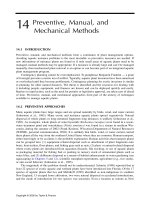Lecture management a pacific rim focus chapter 14 managerial communication
Bạn đang xem bản rút gọn của tài liệu. Xem và tải ngay bản đầy đủ của tài liệu tại đây (501.05 KB, 21 trang )
CHAPTER 14
MANAGERIAL COMMUNICATION
© 2003 McGraw-Hill Australia Pty Ltd. PowerPoint
1
LECTURE OUTLINE
•
•
•
•
Nature of managerial communication
Individual communication & Interpersonal processes
Group communication
Organisational communication channels
© 2003 McGraw-Hill Australia Pty Ltd. PowerPoint
2
Managerial communication
• Communication:
Exchange of messages between people to achieve
common meanings.
• Verbal:
Written or oral use of words to communicate.
• Non-verbal:
Communication by means of elements and
behaviours that are not coded into words.
© 2003 McGraw-Hill Australia Pty Ltd. PowerPoint
3
Managerial communication
Tours
3%
Unscheduled
meetings
12%
Desk work
26%
Telephone
calls
9%
Scheduled
meetings
50%
© 2003 McGraw-Hill Australia Pty Ltd. PowerPoint
4
Communication process
Noise
Noise
Sender/receiver
Sender/receiver
Noise
Noise
Encoding
Encoding message
message
Feedback
Feedback
Medium
Medium
Feedback
Feedback
Decoding
Decoding message
message
Noise
Noise
Sender/receiver
Sender/receiver
© 2003 McGraw-Hill Australia Pty Ltd. PowerPoint
Noise
Noise
5
Individual communication
Interpersonal processes
•
•
•
•
•
Perceptual processes
Attribution process
Semantics
Cultural context
Communication skills
© 2003 McGraw-Hill Australia Pty Ltd. PowerPoint
6
Individual communication
Interpersonal processes
Perceptual processes
Process individuals use to acquire and make sense
out of information from the environment.
• Three stages:
Selecting, organising, interpreting
• Distortions:
Stereotyping, Halo effect, Projection, Perceptual
defence
© 2003 McGraw-Hill Australia Pty Ltd. PowerPoint
7
Individual communication
Interpersonal processes
Attribution process
Theory attempting to explain how individuals make
judgements or attributions about the cause of another’s or,
their own, behaviour.
• Fundamental attribution error:
Tendency to underestimate situational influences & to
overestimate dispositional influences.
• Self-serving bias:
Attributing oneself as responsible for successes & others for
failures.
© 2003 McGraw-Hill Australia Pty Ltd. PowerPoint
8
Individual communication
Interpersonal processes
Semantics:
• Semantic net
Network of words and word meanings a given individual has
available for recall.
• Semantic blocks
Blockages or communication difficulties arising from word
choices.
© 2003 McGraw-Hill Australia Pty Ltd. PowerPoint
9
Individual communication
Interpersonal processes
Cultural context:
High-context
High-context cultures
cultures
‘…emphasise
‘…emphasise
establishing
establishing&
&
strengthening
strengthening
relationships
relationships
in
incommunication
communication
while
while exchanging
exchanging
Information’
Information’
Examples:
Examples:Asia,
Asia,China
China
Low-context
Low-context cultures
cultures
‘…emphasis
‘…emphasisisison
on
information
informationexchange
exchange
&
&less
lessfocussed
focussedon
on
building
building
relationships
relationshipsby
by
Communication’
Communication’
Examples:
Examples:Germany,
Germany,NZ,
NZ,
Australia
Australia
© 2003 McGraw-Hill Australia Pty Ltd. PowerPoint
10
Individual communication
Interpersonal processes
Communication skills:
Active
Activelistening:
listening: ‘…listener
‘…listener
actively
activelyparticipates
participatesin
in
attempting
attemptingto
tograsp
graspfacts
facts&&
the
thespeaker’s
speaker’sfeelings’
feelings’
Feedback:
Feedback:both
bothgiving
giving&&
receiving
receivingisisimportant.
important.
Deal
Dealwith
with‘…specific,
‘…specific,
observable
observablebehaviour,
behaviour,
not
notgeneralities.’
generalities.’
Importance
Importanceof
ofseeking
seeking
customer
customerfeedback
feedback
Effective
Effective
communication
communication
© 2003 McGraw-Hill Australia Pty Ltd. PowerPoint
11
Group communication networks
Communication network:
Pattern of information flow among task-group
members.
© 2003 McGraw-Hill Australia Pty Ltd. PowerPoint
12
Group communication networks
Chain
Centralised
X
Y
Wheel
X
X
All-channel
Decentralised
Circle
© 2003 McGraw-Hill Australia Pty Ltd. PowerPoint
13
Organisational communication
channels
Communication channels:
Patterns of organisational communication flow
representing potential established conduits through
which managers and other organisation members
can send and receive information.
• Vertical communication
• Horizontal communication
• Informal communication
© 2003 McGraw-Hill Australia Pty Ltd. PowerPoint
14
Organisational communication
channels
Vertical communication:
Lateral or diagonal message exchange either within
work unit boundaries, involving peers, reporting to
the same supervisor, or across work-units
boundaries, involving individuals who report to
different supervisors or, across work unit
boundaries.
© 2003 McGraw-Hill Australia Pty Ltd. PowerPoint
15
Organisational communication
channels
Vertical communication:
• Downward communication
– Can be distorted by faulty message due to sender error.
– Managers overuse downward communication.
– Filtering (deliberate or accidental).
• Upward communication
– Can be distorted by ‘only’ favourable messages going up.
– Managers don’t encourage upward flow.
© 2003 McGraw-Hill Australia Pty Ltd. PowerPoint
16
Organisational communication
channels
Horizontal communication:
Lateral or diagonal message exchange within work-unit
boundaries, involving peers reporting to the same supervisor, or
across work-unit boundaries, involving individuals who report to
different supervisors.
Impeding factors:
• Rivalry
• Indifference to work of others
• Low motivation due to discouraging of horizontal
communication
© 2003 McGraw-Hill Australia Pty Ltd. PowerPoint
17
Organisational communication
channels
Informal communication:
Communication which takes place without regard to
hierarchical or task requirements.
Problems:
• Can carry gossip/distorted information.
Benefits:
• Valuable tool for continuation/propagation of culture.
© 2003 McGraw-Hill Australia Pty Ltd. PowerPoint
18
Organisational communication
channels
Electronic mail
Groupware
Electronic
communication
Internet
Videoconferencing
Voice mail
Teleconferencing
© 2003 McGraw-Hill Australia Pty Ltd. PowerPoint
19
Lecture summary
• Nature of managerial communication
– Verbal, non-verbal
• Individual communication & interpersonal processes
– Attribution process
– Semantics
– Cultural context
– Communication skills
© 2003 McGraw-Hill Australia Pty Ltd. PowerPoint
20
Lecture summary
• Group communication
Networks
• Organisational communication channels
Vertical
Horizontal
Informal
© 2003 McGraw-Hill Australia Pty Ltd. PowerPoint
21









